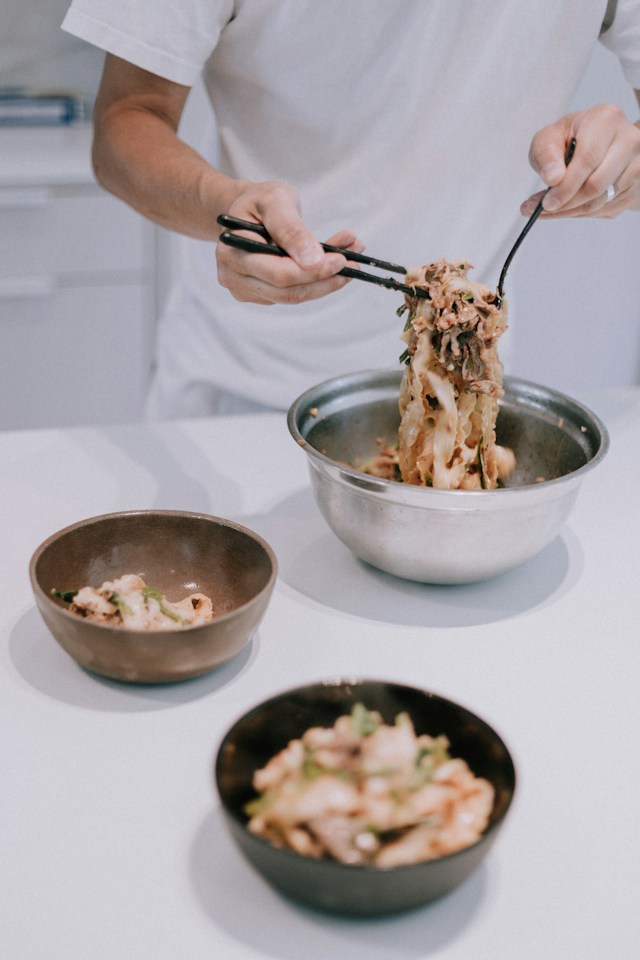How to cook authentic thai curries?

Indulging in a hearty, flavorful Thai curry is an experience that few food adventurers can miss. Steeped in the aromatic richness of herbs and spices, Thai curry represents a universe of exotic flavors. Today, we unravel the secrets behind those magical curry pastes, the aroma of fresh coconut milk, the spiciness of red and green chilies, the tanginess of lime, and the unique texture of chicken perfectly cooked in simmering sauces. We will guide you to recreate this tantalizing journey of Thai flavors in your own kitchen. So, gather your apron, your enthusiasm, and your ingredients – let’s get cooking!
Crafting Curry Paste from Scratch
The heart and soul of every Thai curry lies in its curry paste. This aromatic blend of herbs, spices, and chilies is the key ingredient that lends a unique identity to each dish. Whether it’s the fiery red or the mild green, creating authentic curry paste is a labor of love.
In parallel : How to prepare classic french onion soup?
Initially, you must gather specific ingredients. For a red curry paste, you will need dried red chilies, while fresh green chilies are required for the green curry paste. Both variants will require garlic, shallots, lemongrass, coriander roots, kaffir lime rind, galangal, shrimp paste, and a bit of salt.
To prepare the paste, soak the chilies in water for about 15 minutes until they soften. Then, finely chop all your ingredients and pound them together using a mortar and pestle until it forms a fine, aromatic paste. Remember, the more you pound, the better the flavors will meld together.
In parallel : How to Craft a Gourmet Fish Dish with a Perfect Skin and Delicate Flavor?
The Role of Coconut Milk
The second critical component of a Thai curry is coconut milk. The creamy texture and the subtle sweetness it adds to the dish is irreplaceable. Thai recipes typically use freshly squeezed coconut milk. However, if you do not have access to fresh coconuts, canned coconut milk will do the trick.
To extract fresh coconut milk, grate the coconut flesh and soak it in warm water. Squeeze the coconut shreds to extract the milk. The first squeeze will give you thick coconut milk, and the second squeeze will result in a thinner variety. Both types are used at different stages of cooking to enhance the flavor and texture of the curry.
The Magic of Cooking Thai Curry
The process of cooking Thai curry involves carefully balancing the flavors and textures. First, heat a generous amount of curry paste in a pan, followed by the addition of thick coconut milk. This mixture should be brought to a gentle simmer.
Once the curry paste has infused the coconut milk, add your protein. Although we are focusing on chicken, you can also use tofu, prawns, or vegetables. Let the chicken cook until it is tender and has absorbed the flavors of the curry paste.
The Green Curry Adventure
The green curry is a milder, sweeter variant, marked by the sharp, refreshing flavors of green chilies, coriander, and kaffir lime leaves. The chicken in green curry is usually cooked with Thai eggplants, which adds a subtle bitterness that beautifully balances the sweetness of the coconut milk.
While cooking green curry, you might want to add a spoonful of palm sugar to enhance the sweet notes. Just like the red curry, the green curry is also simmered until the chicken is tender and the flavors meld together into a harmonious whole.
The Finishing Touches
Every Thai curry ends with a flourish of finishing touches. This usually involves a squeeze of fresh lime juice, a scattering of fresh basil or kaffir lime leaves, and an extra swirl of coconut milk.
The lime juice adds a tangy kick to balance the richness of the curry, while the basil or lime leaves add an aromatic freshness. The swirl of coconut milk, added right at the end, gives the curry a luxuriously creamy texture.
Remember, cooking Thai curry is an art, and just like any form of art, it requires patience, passion, and a dash of creativity. Different regions of Thailand have their variants and interpretations of these classic curries. So, feel free to experiment with ingredients and flavors to create a Thai curry that takes you on a culinary journey to the heart of Thailand.
The Allure of Yellow Curry and Coconut Cream
The yellow curry is a popular choice for those who enjoy a more savoury and less spicy curry. The curry paste for yellow curry is distinguished by the addition of turmeric and curry powder, lending it a vibrant yellow color. Thai yellow curry paste also includes a mix of coriander seeds, cumin, lemongrass, galangal, kaffir lime leaves, and, of course, yellow chilies.
To make the yellow curry, fry the yellow curry paste in coconut oil until aromatic. Add chicken pieces and stir to coat each piece with the paste. Once the chicken is partially cooked, pour in the coconut cream – a thicker and richer version of coconut milk. Coconut cream adds a velvety texture and a rich sweetness, providing a beautiful contrast to the savoury, spice-infused chicken.
The addition of potatoes and onions to the yellow curry imparts a pleasant earthiness and crunch. As the curry simmers, the potatoes absorb the flavors, turning into tasty morsels of delight. Towards the end of the cooking, a dash of fish sauce brings an umami punch that rounds off the curry’s flavor profile.
Incorporating Herbs and Sweeteners
In order to perfectly balance the heat of the curry and the rich creaminess of the coconut milk, Thai curries often include herbs and sweeteners. Thai basil is a popular choice, with its anise-like flavor and aromatic notes. It not only adds a distinct flavor but also injects a vibrant green color, making the curry visually appealing.
Another critical ingredient in Thai curry recipes is palm sugar. Palm sugar offers a natural sweetness that counteracts the spice and enhances the overall flavor of the curry. It’s traditionally used in Thai green and red curry, but you can also experiment with it in your yellow curry.
While preparing your Thai curry, remember to add the sweeteners and herbs towards the end. Cooking them for too long may result in the loss of their fresh flavors and vibrant colors.
Wrapping It Up: The Final Verdict on Thai Curries
In conclusion, cooking authentic Thai curries is a culinary adventure that’s not just about the end result, but also the process. It challenges you to balance complex flavors, work with exotic ingredients, and create a dish that’s visually appealing and incredibly delicious.
Whether you’re making red curry, green curry, or yellow curry, the heart of the dish always lies in the curry paste. The combination of herbs, spices, and chilies create a flavor-packed base, which is then beautifully contrasted with the creaminess of coconut milk or coconut cream. Additions like chicken, tofu, fish sauce, Thai basil, and palm sugar add depth and diversity to the dish, making every bite a unique experience.
Although making Thai curry requires patience and precision, it’s an investment worth making. The burst of flavors and the satisfaction of creating something so delicious from scratch is unparalleled. So, go on, don your apron, and embark on a culinary journey to Thailand, right from the comfort of your kitchen! Don’t forget to garnish your curry with a handful of fresh Thai basil leaves and a squeeze of lime for that extra zing. Happy cooking!
